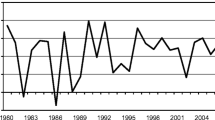Abstract
There has been considerable debate about the major factors responsible for the dramatic decline of China’s energy intensity in the 1980s and 1990s. However, few detailed analysis has been done to explain the fluctuation in energy intensity during 2002–2005. In this paper, we use the structural decomposition analysis (SDA) to decompose energy intensity into five determining factors: Energy input coefficient, technology coefficient (Leontief inverse coefficient), final demands structure by product, final demands by category and final energy consumption coefficient. We then further decompose two coefficients, energy input coefficient and technology coefficient, into structure and real coefficient. Empirical study is carried out based on the energy-input-output tables from 1987 to 2005 in 2000 constant price. The results show that between 1987 and 2002, energy input structure accounts for most of the decline in energy intensity. However, the input structure and final demands structure by product explain the increase of the energy intensity between 2002 and 2005.
Similar content being viewed by others
References
X. Lin and K. R. Polenske, Input-output anatomy of China’s energy use changer in the 1980s, Economic Systems Research, 1995, 7(1): 67–83.
R. F. Garbaccio and S. H. Mun, Why has the energy-output ratio fallen in china? Energy Journal, 1999, 20(3): 63–91.
K. Fisher-Vanden and G. H. Jefferson, What is driving China’s decline in energy intensity? Resource and Energy Economics, 2004, 26: 77–97.
L. Q. Ding etc, The decomposition model and analysis of energy consumption per unit GDP, Energy Research and Information, 2007, (3): 146–153.
Y. Zhou and L. S. Li, The change factors of energy intensity in china based on AWD, Charcoal economy research, 2006, (5): 39–43.
J. P. Huang, Industry energy use and structural change: A case study of The People’s Republic of China, Energy Economics, 1993, (15): 131–136.
Z. X. Zhang, Why did the energy intensity fall in china’s industrial sector in the 1990s? the relative importance of structural change and intensity change, Energy Economics, 2003, (25): 625–638.
C. B. Ma and D. I. Stern, China’s changing energy intensity trend: A decomposition analysis, working papers, Rensselaer Polytechnic Institute, 2006.
S. Kagawa and H. Inamura, A simple multi-regional input-output account for waste analysis, Economic Systems Research, 2004, 1(16): 3–22.
S. Kagawa and H. Inamura, A structural decomposition of energy consumption based on a hybrid rectangular input-output framework: Japan’s case, Economic Systems Research, 2001, 4(13): 339–363.
Mukhopadhyay and Chakraborty, India’s energy consumption changes during, Economic Systems Research, 1999, 4(11): 423–438.
V. Alcantaraa and R. Duarte, Comparison of energy intensities in European Union countries: Results of a structural decomposition analysis, Energy Policy, 2004, 32: 177–189.
P. Tiwari, An analysis of sectoral energy intensity in India, Energy Policy, 2000, 28: 771–778.
E. Dietzenbacher and B. Los, Structural decomposition techniques: Sense and sensitivity, Economic Systems Research, 1998, 10(4): 307–24.
M. de Haan, A structural decomposition analysis of pollution in the netherlands, Economic Systems Research, 2001, 2(13): 181–196.
Author information
Authors and Affiliations
Corresponding author
Additional information
This research is supported by the National Natural Science Foundation of China under Grant Nos. 70871108, 70810107020.
This paper was recommended for publication by Editor Shouyang WANG.
Rights and permissions
About this article
Cite this article
Xia, Y., Yang, C. & Chen, X. Structural decomposition analysis on China’s energy intensity change for 1987–2005. J Syst Sci Complex 25, 156–166 (2012). https://doi.org/10.1007/s11424-012-9061-4
Received:
Revised:
Published:
Issue Date:
DOI: https://doi.org/10.1007/s11424-012-9061-4




